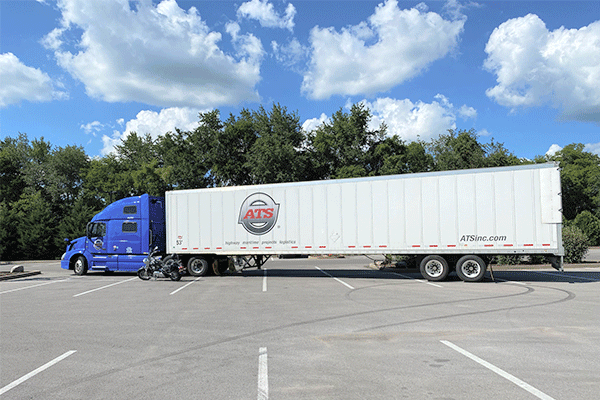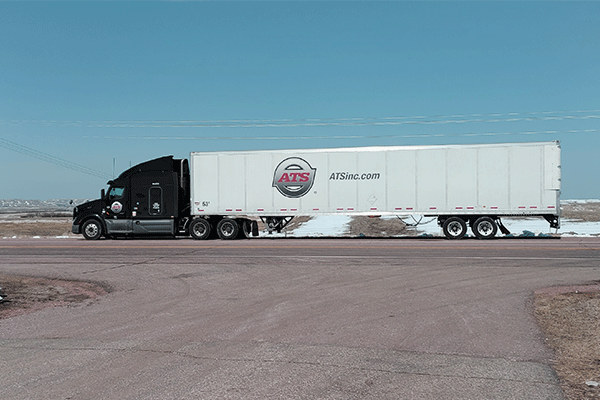
So you want to move some dry van freight. Not only that but you’re committed to sticking to a set budget this time around. That said, you realize how failing to understand the way dry van rates are calculated can make meeting your financial goals difficult.
Too many shippers are left at a disadvantage leading up to the time their dry van commodities load. Simply allowing transportation companies to quote your freight, without grasping how they do so, can be damaging to your long-term success. The more work you put in now to understand how dry van freight is quoted, the better off you’ll be in the future. And so, here you are.
Here at ATS, we offer dry van transportation services to many areas of the United States so we understand the intricacies of this process. Dry van trailers are some of the most popular trailers on America’s roads as they provide a steady solution for a vast number of products.
As such, if you’re a shipper who has used dry vans in the past, it’s likely that you’ll be doing so for many years to come. In this blog, we’ll tell you what you need to know about the cost of dry van shipping. This includes what it’ll take to move freight not only with ATS but with many of this nation’s providers.
How Are Dry Van Freight Rates Calculated?
Moving cargo inside of a 48 to 53-foot dry van is done so frequently throughout America, it’s becoming something of a science. In fact, dry van rates can be some of the easiest transportation services to quote.
Digital freight brokerages, which are essentially technology-based transportation providers with limited human input, can shoot out dry van quotes in a matter of moments. As the number of variables increases, however — like with a heavy haul shipment — this becomes increasingly tricky and, in some cases, impossible.
Sure, digital freight brokerages may miss the mark with their quotes — based on current market conditions. But dry van shipping certainly doesn’t boast as many intricacies as other services — relatively speaking.
This is not to say that quoting dry van freight is easy. Keeping these trailers loaded and moving is a delicate process that many trucking companies struggle to get right.
Owning a fleet of dry van trailers, class-8 semi-tractors and keeping a payroll of drivers is a huge investment for these companies. Because of this, they need to get the best possible use out of them. Anything less simply doesn’t make sense.
To do this, dry van carriers provide shippers rates calculated based, primarily, on the total amount of time their assets are dedicated to each load.
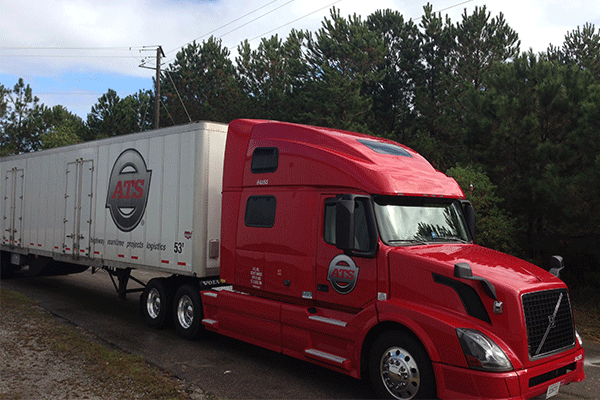
Why Does Total Time On Your Load Matter?
Truck drivers are subject to strict guidelines dictating how much time they can spend hauling freight. These regulations — enforced by the Federal Motor Carrier Safety Administration (FMCSA) — are a trucker’s hours of service (HOS).
As it currently sits, HOS regulations state that a dry van truck driver can be actively “on-duty” for 14 total hours — within a 24 hour period. 11 of these hours can be spent behind the wheel of their truck while the remaining three must be dedicated to break periods.
While a trucker’s clock resets — with a 10-hour break after their 14 hours of service ends — their truck, trailer and all of its contents are immobilized. Nothing moves while a trucker resets their clock. And moving freight is the only way they make money.
As such, the amount of time they spend on your freight matters greatly to the final dollar amount you’ll pay to move it. A trucker’s total commitment to your load includes front-end loading times, total transit distance/time and back-end unloading times.
How Does Time On Your Load Impact Your Price?
Since trucking companies, like ATS, work to maximize the productivity of their fleet you should expect more competitive pricing as the amount of time on your load decreases.
For example:
When your freight’s loading time + transit time + unloading time = less than 10 hours, the trucker charged with moving it will be left with HOS remaining on their clock. This gives them the flexibility to get into position for their next pick-up, and maybe even start the process of hauling another load.
In the interest of increasing truck driver efficiency, carriers like to haul time-conscious loads like these and often price them at a cost-savings to the shipper.
On the flip side, should your shipment’s load time + transit time + unload time = 10-14 hours, expect to pay more. In these instances, a driver’s on-duty hours will be fully dedicated to hauling your load. As a result, these truckers need to be compensated for a full day’s worth of work, increasing your price.
In the end, the rate you’re given comes down to how well your freight fits the needs of your trucking company. If your load makes it easy for them to maximize efficiencies, transporting it may come at a relaxed rate.
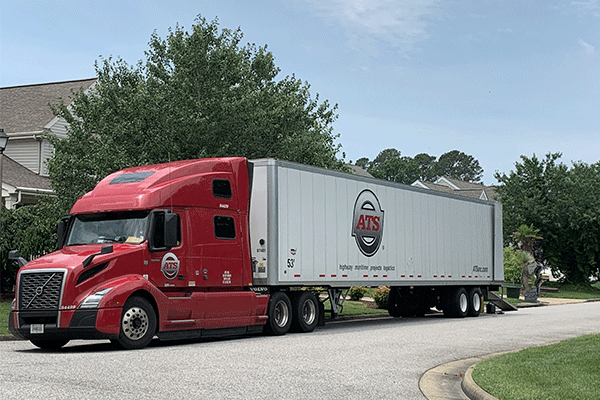
What Will Your Dry Van Shipment Cost?
$1.50-$3.50 per mile, with a $1,000-$1,500 minimum cost (on average)
Depending on what you prefer, you’ll either be given a rate-per-mile (RPM) or line haul rate for your shipment. Although the final dollar amount of each dry van load doesn’t change, sometimes shippers like the holistic ballpark figure of a line haul rate over that of a RPM.
Even though this varies based on the complexity and specifics of each load — including their network fit — you should expect to receive a rate-per-mile that hovers between $2 and $4 for dry van freight.
That said, in the interest of keeping truck drivers well paid, a shipment’s rate will increase or decrease depending on how much of a driver’s working hours you utilize.
If your dry van load — due to prolonged loading times or otherwise — soaks up the entirety of a trucker’s daily HOS, expect to pay a minimum rate of between $1,000-$1,500 to compensate them for their time. Time they could’ve spent hauling something else.
Consider this:
Let’s say you need a trucker to pick up your freight at 10 a.m. and travel 200 miles to your destination. When accounting for pick-up and drop-off times, this load should, realistically, take a driver no more than six hours to complete. And upon completion, this trucker should be left with a healthy five remaining hours of on-duty drive time to get to their next load.
With proper planning, a load like this allows the carrier moving it to truly maximize their truck driver’s HOS and plan a pick-up on the back-end. As such, this load could be priced at a highly competitive RPM and allow you to dip below $800 in total. Not too shabby.
Now, let’s consider another, more costly, scenario.
This time, the same load can’t be delivered until 9 a.m. the next morning — nearly 24 hours after it originally loaded.
Instead of simply loading up, driving 200 miles from A to B and unloading freight in a timely manner, this trucker is required to wait.
Since this trucker’s clock doesn’t stop while waiting for a drop-off appointment, the entirety of their service hours are exhausted on this 200-mile load. In this case, dry van freight like this will be quoted around an average minimum rate of $1,000.
What’s the moral of this story? Killing a driver’s clock and tying up a carrier’s truck and trailer for multiple days will increase your rate regardless of how far they drive.
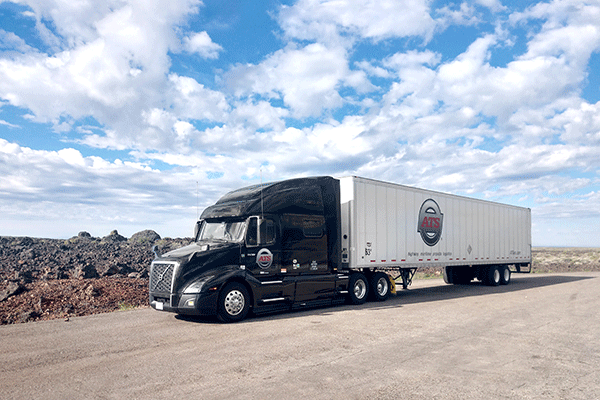
What About Fuel Surcharge Fees?
It’s important to note that neither the line-haul rate of $900 dollars or the $4.50 RPM on a 200-mile shipment —which end up equaling the same thing — include the cost of fuel.
Fuel surcharges (FSC) — calculated based on the Department of Energy’s current fuel prices — are tacked to dry van rates following successful delivery.
Here at ATS, the truckers in our vans fleet are given the entirety of the FSCs paid by the shippers we work with. This helps to ensure that every trucker is compensated for the dollars they spend while moving shipments from A to B.
Carriers, like ATS, consistently strive to keep their trucks moving as much as possible and, depending on the specifics of each shipment, this can be difficult.
What Other Factors Impact Your Dry Van Rates?
Total time spent on your load, although an important metric, isn’t the only factor that influences your final price. So let’s look at some of the other major components that —depending on your load — raises or lowers your rate.
These are:
- The location/region of your origin and destination
- The consistency of your shipping needs
- The specific needs of your freight
- The urgency of your shipment
1. How Do Your Locations Impact Your Freight Rate?
Trucking companies typically have a limited number of assets (trucks and trailers). The location of these assets — called their network domicile — is usually quite specific. Be it a certain region, established area or grouping of regions, where your partner’s trucks are concentrated will impact your rate.
If you ship from an area of strength for your provider — as it relates to their network presence — you’ll likely get a relaxed price. The easier it is for your trucking company to find their trucker’s next load — and a solution for your shipment — the better off you’ll be.
Shipping into an area of weakness for your provider, on the other hand, will increase your rates. At the end of the day, the better your needs fit the well-worn networks (trucks and customers) of your provider, the better.
Related: The Top 5 Most Expensive Shipping Destination Types
2. How Does Consistency Impact Your Shipping Price?
Consistent demand is very attractive to trucking companies. As a result, they like working with shippers who move freight consistently. In these instances, it’s easier for carriers to plan out their trucks in accordance with their customer’s schedules.
When transportation providers know where their trucks will be utilized, including how long each shipment will take — information gained from repeated partnership — it’s easier for them to competitively price freight.
3. How Does Your Shipment’s Needs Impact Your Rate?
Value-add services for dry van shipments directly influence the price of moving these goods.
Accessorials — as they’re called — make the lives of shippers easier but, unfortunately, aren’t offered for free. Should you need blanket wrapping, detention, multiple stops, drop trailers or any number of added dry van charges, expect your rate to increase.
Related Article: The #1 Way to Avoid Additional Charges in the Trucking Industry
4. How Does Urgency Impact Your Dry Van Rates?
Trucking companies have a limited number of assets and they like to schedule their loads out days at a time. As a result, it can be difficult to provide shippers capacity on too short of notice.
Slipping your freight onto their jammed-packed schedules may be highly disruptive to your carrier’s timelines. This disruption will increase your pricing substantially. In some cases, last-minute shipments will be too difficult to accommodate for dry van carriers who are in constant demand.
Make the Most of Your Dry Van Shipping Budget
Your dry van freight rates can really add up, but they certainly don’t have to.
To ensure you make the most of your next dry van shipment, here are three tried and true tactics to help you along.
1. Give Your Provider Plenty of Lead Time
The importance of giving your provider plenty of warning to plan out your shipment and coordinate your truck, can’t be overstated. Although this can sometimes prove difficult, giving your partner a lead time of 24 to 72 hours prior to when your freight needs to load will save you money substantially.
Anything less 24 hours of lead time will create disruption for the trucking company you choose, increasing your day rates/RPM as securing capacity — that’s normally booked days in advance — becomes challenging.
2. Add Flexibility to Your Pick-Up and Drop Windows
Coordinate with your dry van trucking company to schedule pick-ups and deliveries. The more you can do to adjust your time frames to their capabilities, the more money you’ll save.
Sometimes, injecting a bit of convenience and flexibility into your shipping schedule can help keep your costs down. Many trucking companies like to plan out their driver’s routes in a way that makes the most of their time. Rigid appointments at either end of your shipments make this more difficult, increasing the price you pay.
3. Ensure Your Provider’s Network Fits Your Needs
Too often, shippers see their dry van rates increase because the company they chose can’t best serve their needs. Since their networks don’t stack up, it’s difficult for carriers without a presence in the regions these shippers need it to give competitive pricing.
To avoid this issue, ask your provider for their domicile map — displaying where their trucks are located — and ask them where their presence is strongest.
For reference, here is the ATS Vans domicile map:
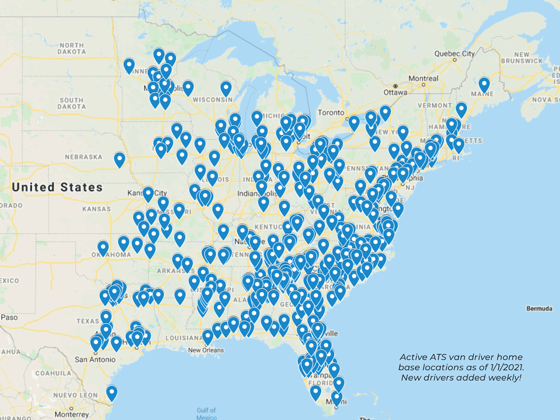
What is Your Dry Van Freight Rate?
Now that you understand how dry van shipping rates are quoted and have some general price ranges to consider, it’s time to receive your very own rate.
Here at ATS, we take pride in offering dry van rates calculated to get the job done. Following your request, rest assured that the price you’re given is the current cost of doing business and, should you have any questions, your transportation expert will work to explain every aspect of your quote until your mind is at ease.
So, whenever you’re ready, reach out to us and request your no-strings-attached dry van shipping rate.

